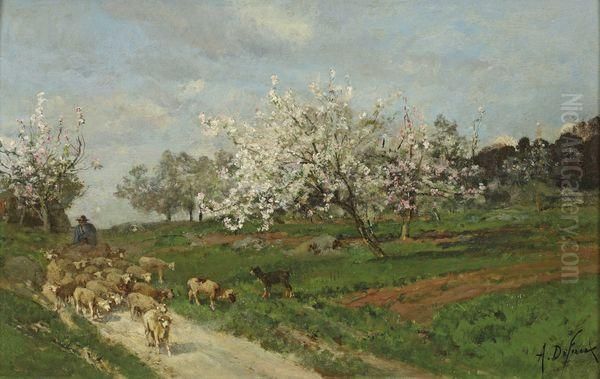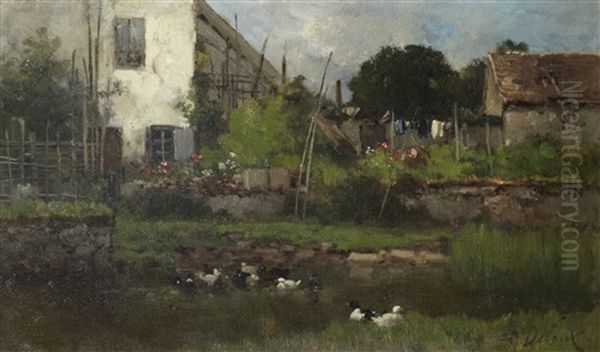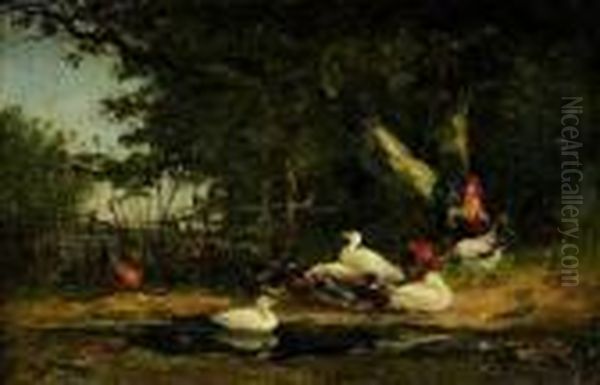Alexandre Defaux (1826-1900) stands as a significant yet sometimes overlooked figure in the rich tapestry of 19th-century French landscape painting. Born in Bercy, a district then on the outskirts of Paris, and later settling within the bustling capital, Defaux dedicated his artistic life to capturing the nuanced beauty of the French countryside. His work, deeply rooted in the traditions of his time yet possessing a distinct personal touch, offers a window into the evolving relationship between artists and the natural world during a period of profound artistic change.
As an art historian examining Defaux's career, one immediately recognizes the profound impact of his tutelage under one of the era's giants, Jean-Baptiste-Camille Corot. This connection, coupled with his active participation within the sphere of the Barbizon School, positions Defaux as a key inheritor and practitioner of a specific approach to landscape painting – one that valued direct observation, atmospheric sensitivity, and a deep reverence for rural life. His long and recognized career, marked by regular Salon exhibitions and prestigious awards, attests to the respect he garnered among his peers and the public.
Early Life and Artistic Awakening
Born in 1826 in Bercy, Alexandre Defaux emerged into a France undergoing significant social and artistic transformation. While details of his earliest years are not extensively documented, his eventual move to Paris placed him at the epicenter of the European art world. It was here that his artistic inclinations found fertile ground, leading him to seek formal training. The most pivotal decision in his formative years was becoming a pupil of Camille Corot.
This apprenticeship was crucial. Corot was already a towering figure, revered for his poetic landscapes that bridged Neoclassical structure with a burgeoning Romantic sensibility and a revolutionary approach to light and tone. Studying under Corot meant more than just learning technique; it involved absorbing a philosophy of looking at nature, understanding its moods, and translating them onto canvas with sincerity and feeling. Defaux proved to be a dedicated student, internalizing the lessons of his master while beginning to forge his own artistic path.
Under the Master's Wing: The Corot Influence

The influence of Camille Corot on Alexandre Defaux's work is undeniable and pervasive. Corot, often hailed as a precursor to Impressionism, was celebrated for his mastery of tonal values, his ability to capture the soft, silvery light of the Île-de-France, and his increasingly free brushwork in his later souvenirs or landscape memories. He encouraged outdoor sketching (plein air studies) to capture immediate impressions, which were often later refined in the studio.
Defaux absorbed these principles deeply. His landscapes frequently exhibit a Corot-like sensitivity to atmosphere and light, particularly the subtle transitions of dawn, dusk, or overcast days. The compositional harmony and the often tranquil, lyrical mood found in many of Defaux's paintings echo his master's approach. However, Defaux was not a mere imitator. While embracing Corot's emphasis on naturalism and light, he often brought a slightly different sensibility, sometimes incorporating more detailed observation or a focus on specific textures, developing what contemporaries noted as his own characteristic "finesse" and "elegance." Other artists also benefited from Corot's guidance, such as Berthe Morisot and Antoine Chintreuil, each interpreting his lessons in their unique ways.
The Call of Nature: Defaux and the Barbizon School
Alexandre Defaux is rightly associated with the Barbizon School, a loose collective of artists who, from the 1830s onwards, gathered near the village of Barbizon on the edge of the Forest of Fontainebleau. This movement represented a decisive shift away from the idealized historical landscapes favored by the Academy towards a more direct, realistic, and often humble depiction of rural France. They sought truth in nature, observed firsthand.
Key figures of the Barbizon School included Jean-François Millet, known for his dignified portrayals of peasant life; Théodore Rousseau, a master of depicting majestic trees and forest interiors; Charles-François Daubigny, who famously painted from his studio boat along the Oise river; Narcisse Diaz de la Peña, noted for his dappled sunlight effects in the forest; Jules Dupré, with his dramatic skies and landscapes; and Constant Troyon, celebrated for his animal painting within landscape settings.
Defaux embraced the Barbizon ethos wholeheartedly. His choice of subjects – tranquil ponds, farmyards, forest paths, grazing animals – aligns perfectly with the movement's focus. He frequently painted in regions favored by the Barbizon painters and their followers, including Normandy, Brittany, and the areas around Fontainebleau, seeking out the unadorned beauty of the French countryside. His commitment to outdoor sketching and capturing the specific character of a location places him firmly within this influential tradition.
A Delicate Realism: Defaux's Artistic Signature

While operating within the frameworks established by Corot and the Barbizon School, Alexandre Defaux developed a distinct artistic signature. His style is often described as possessing a particular "delicacy" and "finesse." This translates visually into a careful, often meticulous handling of paint, especially in rendering the textures of foliage, the feathers of birds, the rough surfaces of stone walls, or the reflective quality of water.
His observation of nature was keen and detailed. Unlike the later Impressionists who would dissolve form in light and colour, Defaux generally maintained a clear sense of structure and form in his compositions. His realism was tempered with a poetic sensibility, avoiding harshness in favor of harmonious arrangements and gentle light. He demonstrated a mastery of oil paint, capable of capturing both broad atmospheric effects and intricate details within the same canvas. His palette, while naturalistic, often favored subtle greens, earthy browns, and soft greys, contributing to the tranquil and often intimate feeling of his works. His still life paintings, though less numerous than his landscapes, similarly showcase this attention to detail and sensitive handling of light and texture.
Painting Rural France: Subjects and Masterworks
The heart of Defaux's oeuvre lies in his depictions of rural France. He was particularly drawn to scenes involving water and animals, subjects that allowed him to explore reflections, light, and the quiet rhythms of country life. Farmyards were a recurring theme, offering opportunities to paint domestic animals like chickens, ducks, and geese with affectionate detail.
Among his representative works, several titles stand out and illustrate his typical subjects and approach:
Le Poulailler (The Henhouse) and Basse-cour (Farmyard/Lower Courtyard): These works exemplify his interest in intimate farm scenes, likely depicting chickens and other fowl in their enclosure. They showcase his skill in rendering textures (wood, straw, feathers) and capturing the everyday life of the countryside.
La route de ferme (The Farm Road): Suggests a focus on pathways leading through rural landscapes, allowing for explorations of perspective and the integration of figures or animals within the broader setting.
Troupeau de moutons près des arbres en fleur (Flock of Sheep near Trees in Bloom): A pastoral scene combining animal painting with the specific light and atmosphere of spring, highlighting his sensitivity to seasonal changes.
Les Bords du Loing (The Banks of the Loing): River landscapes were a staple for many Barbizon and Impressionist painters. This work likely features the tranquil Loing river, allowing for studies of water, reflections, and riverside vegetation.

La Mare aux canards (The Duck Pond): Another characteristic subject, focusing on waterfowl in their natural habitat, showcasing his ability to paint water and animal life convincingly.
Other documented works further illustrate his range, including specific locations like At Ivry, The Gravelines River on the Coast, The Eure Plateau, The Marshes of Montier-en-Der, Pont-Aven in front of the Rousseau Palace, and Spring at Versailles. Titles like Dawn in the Forest, Spring in Lorraine, Old Willows at Montier-en-Der, and Garden in a Storm indicate his interest in different times of day, seasons, and weather conditions. His still lifes, such as Bouquet in a Jardinière, and even a more exotic subject like Le Bazaar, Istanbul, demonstrate a versatility beyond pure landscape.
Recognition and Esteem: The Salon and Awards
In the 19th-century French art world, official recognition often came through the Paris Salon, the annual (or biennial) exhibition organized by the Académie des Beaux-Arts. Success at the Salon could significantly boost an artist's reputation and commercial prospects. Alexandre Defaux began exhibiting regularly at the Salon in 1859, consistently submitting works throughout his career.
His dedication and talent did not go unnoticed. He received several medals and honors over the years, culminating in two particularly prestigious awards. In 1881, he was made a Chevalier of the Legion of Honour (Légion d'honneur), France's highest order of merit, a significant acknowledgment of his contribution to French art and culture. This award placed him among the respected figures of the art establishment.
Furthermore, towards the end of his life, he received a Gold Medal at the Exposition Universelle (World's Fair) held in Paris in 1900. These international exhibitions were major cultural events, and winning a gold medal there was a testament to his enduring skill and reputation on both a national and international stage. These accolades confirm that Defaux was not a marginal figure but a well-regarded artist within the mainstream of his time.
Wider Circles: Pont-Aven and the Impressionist Age
Defaux's artistic life also included interactions beyond the immediate circle of Corot and the Barbizon painters. Evidence suggests he visited Pont-Aven in Brittany, a village that would later become famous as a center for Post-Impressionist artists. During his time there, he reportedly interacted with other painters, including the American artist Thomas Hovenden.

It's important to place Defaux's visit in context. While Pont-Aven is now strongly associated with Paul Gauguin, Émile Bernard, and the development of Synthetism in the late 1880s and 1890s, Defaux's presence there likely predates this later, more radical phase. His connection to Pont-Aven highlights the village's long-standing appeal to landscape painters drawn by its picturesque scenery and traditional Breton culture, even before the arrival of the Post-Impressionists.
Living and working through the rise of Impressionism, Defaux occupied an interesting position. He shared the Impressionists' interest in light, atmosphere, and plein air observation, likely influenced by the same currents that shaped artists like Claude Monet, Alfred Sisley, and Camille Pissarro (who, like Defaux, had connections to Corot). However, Defaux's style remained distinct. He generally retained a more solid structure, detailed finish, and tonal approach characteristic of the Barbizon tradition, rather than adopting the broken brushwork, vibrant palette, and focus on fleeting moments that defined core Impressionism as practiced by Monet or Pierre-Auguste Renoir. He represents a continuation and refinement of the Barbizon aesthetic in the face of newer artistic revolutions.
Enduring Landscapes: Later Years and Legacy
Alexandre Defaux continued to paint until his death in Paris in 1900, the same year he received the Gold Medal at the Exposition Universelle. His long career spanned a period of immense change in French art, from the consolidation of Romanticism and Realism through the Barbizon school to the advent of Impressionism and Post-Impressionism. Throughout these shifts, Defaux remained largely faithful to his artistic vision, rooted in the careful observation of nature and influenced by the poetic realism of his teacher, Corot.
His legacy is that of a highly skilled and respected painter of the French landscape. While perhaps not as revolutionary as some of his contemporaries, his work holds significant value for its consistent quality, its sensitive portrayal of rural France, and its embodiment of the Barbizon spirit. His paintings continue to be appreciated by collectors and institutions. Auction records, such as the reported sales of Le Poulailler for €1500-1800 and La Mare aux canards for €4800-5000, indicate a sustained market interest. His works are held in various museum collections, ensuring their accessibility for future study and appreciation. He stands as an important representative of the generation of landscape painters who followed Corot, translating the master's lessons into their own sincere and often beautiful depictions of the natural world.
Conclusion

Alexandre Defaux carved a distinct niche for himself within the landscape tradition of 19th-century France. As a devoted student of Camille Corot and an active participant in the Barbizon movement, he mastered the art of capturing the subtle beauties of the French countryside. His paintings, characterized by their delicate realism, sensitivity to light and atmosphere, and often intimate focus on rural life and nature, offer a tranquil and enduring vision. While navigating an era of dramatic artistic innovation, Defaux maintained a consistent and highly skilled approach, earning significant recognition during his lifetime. Today, his work serves as a vital link in the lineage of French landscape painting, representing the enduring appeal of the Barbizon ethos and the quiet poetry found in the careful observation of the natural world. He remains a testament to the depth and diversity of artistic expression in one of art history's most dynamic periods.